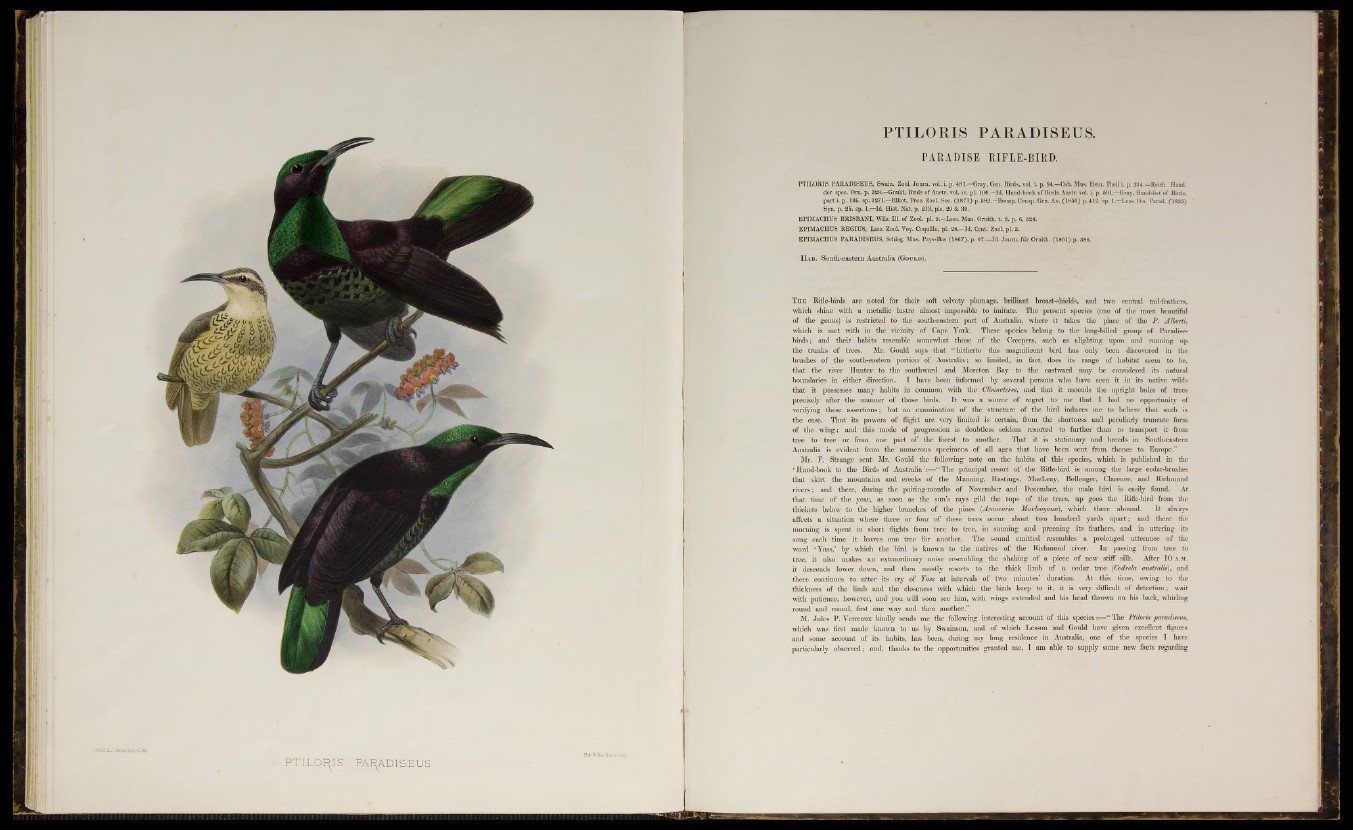
P T IL O R IS PAP^AD IS E U S
PARADISE RIELE-BIRD.
PTILORIS PARADISEUS, Swain. Zool. Journ. vol. i. p. 481.—Gray, Gen. Birds, vol. i. p. 94.—Cab. Mus. Hein. Theil i. p. 214.—Reich. Hand,
der spec. Om. p. 328.—Gould, Birds o f Austr. vol. iv. pi. 100.—Id. Hand-book o f Birds Austr. vol. i. p. 691.—Gray, Hand-list'of Birds,
part i. p. 106. sp. 1271.—Elliot, Proc. Zool. Soc. (1 8 7 1 ) p. 582. —Bonap. Consp. Gen. Av. (1 850) p. 412. sp. 1.—Less. Ois. Parad. (1836)
Syn. p. 26. sp.;l.'—Id. Hist. Nat. p. 213, pis. 29 & 30.
EPIMACHUS BRISBANI, Wils. IU. o f Zool. pi. 9.—Less. Man. Omith. t , iis p. 6, 320.
EPIMACHUS REGIUS, Less. Zool. Voy. Coquille, pi. 28,—Id. Cent. Zool. pi. 3. '
EPIMACHUS PARADISEUS, Schleg. Mus. Pays-Bas (18.67), p. 97.—Id. Journ. fur Omith. (1 861) p. 386.
H a b . South-eastern Australia (G o u ld ) .
T h e Rifle-birds are noted for their soft velvety plumage, brilliant breast-shields, and two central tail-feathers,
which shine with a metallic lustre almost impossible to imitate. The present species (one of the most beautiful
of the genus) is restricted to the south-eastern part of Australia, where it takes the place of the P. Alberti,
which is met with in the vicinity of Gape York. These species belong to the long-billed group of Paradise-
birds; and their habits resemble somewhat those of the Creepers, such as alighting upon and running up
the trunks of trees. Mr. Gould says that “ hitherto this magnificent bird has only been discovered in the
brushes of the south-eastern portion of Australia; so limited, in fact, does its range of habitat seem to be,
that the river Hunter to the southward and Moreton Bay to the eastward may he considered its natural
boundaries in either direction. I have been informed by several persons who have seen it -in its native wilds
that it possesses many habits in common with the Climacteres, and that it ascends the upright boles of trees
precisely after the manner of those birds. It was a source of regret to me that I had no opportunity of
verifying these assertions; but an examination of the structure of the bird induces me to believe that such is
the case. That its powers of flight are very limited is certain, from the shortness and peculiarly truncate form
of the wing ; and this mode of progression is doubtless seldom resorted to further than to transport it from
tree to tree or from one part of the forest to another. That it is stationary and breeds in South-eastern
Australia is evident from the numerous specimens of all ages that have been sent from thence to Europe.”
Mr. E. Strange sent Mr. Gould the following- note on the habits of this species, which is published in the
‘ Hand-book to the Birds of Australia’:—“ The principal resort of the Rifle-bird is among the large cedar-brushes
that skirt the mountains and creeks of the Manning, Hastings, MacLeay, Bellenger, Clarence, and Richmond
rivers; and there, during the pairing-months of November and December, the male bird is easily found. At
that time of the year, as soon as the sun’s rays gild the tops of the trees,-up goes the Rifle-bird from the
thickets below to the higher branches of the pines (Araucaria Macleayana), which there abound. It always
affects a situation where three or four of these trees occur about two hundred yards apart; and there the
morning is spent in short flights from tree to tree, in sunning and preening its feathers, and in uttering its
song each time it leaves one tree for another. The sound emitted resembles a prolonged utterance of the
word ‘ Yass,’ by which the bird is known - to the natives of the Richmond river. In passing from tree to
tree, it also makes an extraordinary noise resembling the shaking of a piece of new stiff silk. After 10 a .m .
it descends lower down, and then mostly resorts to the thick limb of a cedar tree (Cedrela australis), and
there continues to utter its cry of Yass at intervals of two minutes’ duration. At this time, owing to the
thickness of the limb and the closeness with which the birds keep to it, it is very difficult of detection; wait
with patience, however, and you will soon see him, with wings extended and his head thrown on his back, whirling
round and round, first one way and then another.”
M. Jules P. Verreaux kindly sends me the following interesting account of this species:—“ The Ptiloris paradiseus,
which was first made known to us by Swainson, and of which Lesson and Gould have given excellent figures
and some account of its habits, has been, during my long residence in Australia, one of the species I have
particularly observed; and, thanks to the opportunities granted me, I am able to supply some new facts regarding